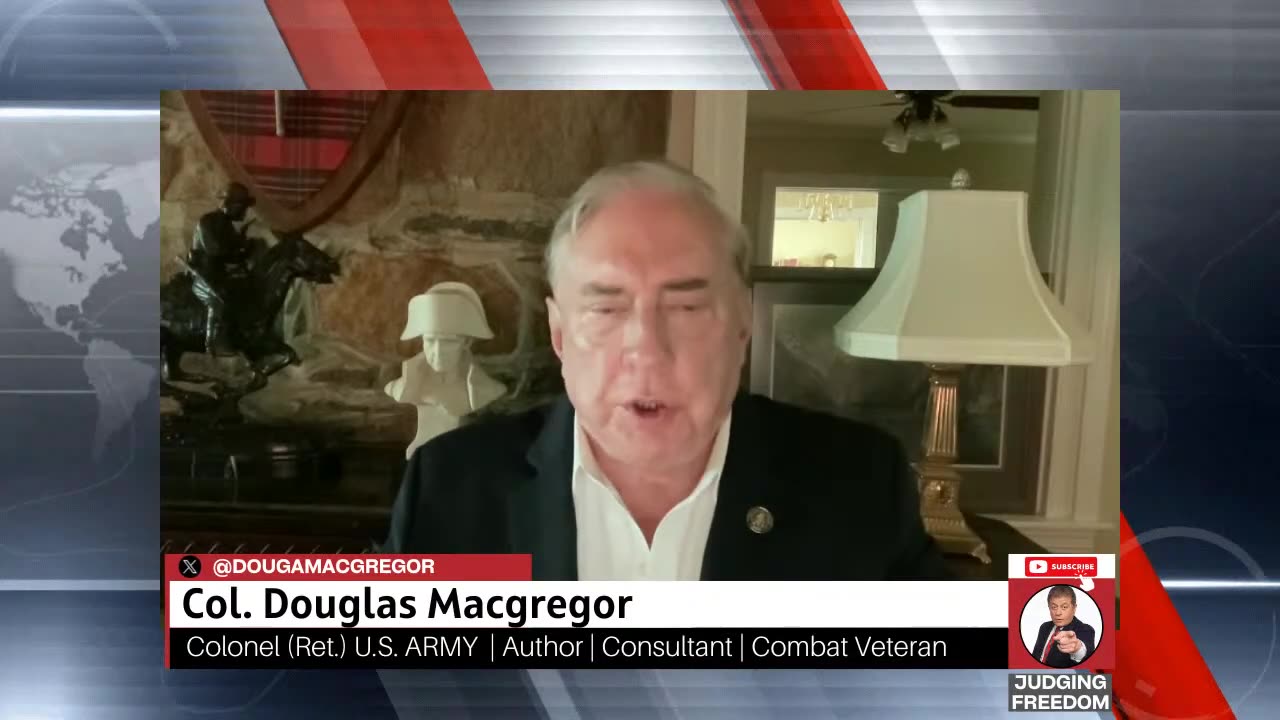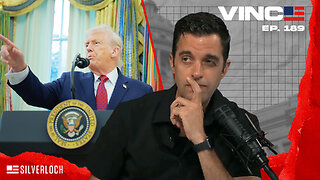Premium Only Content

Colonel Douglas MacGregor Puts the Rules of Engagement on the Record
Colonel Douglas MacGregor Puts the Rules of Engagement on the Record
Americans can be shot on American soil.
What is the White Flag of Truce?
The White Flag of Truce
Google AI Overview
Original: the white ...
What is the white flag of parley?
What does the white flag mean in a truce?
What does a white flag symbolize in battle?
White flag of surrender hi-res stock photography and images ...
A white flag is indeed used in warfare as a symbol of truce, ceasefire, and a request for negotiation or parley. Displaying a white flag indicates a desire to cease hostilities and initiate a discussion or conference with the opposing side. It is a recognized international symbol, and waving a white flag by one side during combat signifies a willingness to stop fighting to negotiate a ceasefire or other terms.
Elaboration:
Symbol of Truce:
The white flag has historically been used as a signal to pause hostilities and begin negotiations, often leading to a truce or ceasefire.
Request for Parley:
A parley is a formal discussion or conference between opposing sides, and the white flag is often used to signal a request for such a parley.
International Law:
International law recognizes the white flag as a symbol of surrender or a request for negotiation, and it is considered illegal to feign surrender with a white flag.
History:
The use of white flags to signal surrender or request negotiation dates back to the Eastern Han dynasty in China and has been observed across various historical periods and cultures.
Defense Department Updates Its Law of War Manual
U.S. Department of Defense (.gov)
defense.gov
Jul 31, 2023 — The Manual provides authoritative legal guidance for DoD personnel in implementing the law of war and executing military operations. It reflects ...
DoD Law of War Manual - DTIC
defense.gov
dod.defense.gov
PDF
May 31, 2016 — The Department of Defense Law of War Manual (June 2015, updated May 2016) incorporates the changes described in the attachment. The original ...11:27 AM Customer Support (System Message)
Please attend the Common Law Academy every Wednesday at 7:00 PM New York time at URL meetn.com/cla
Full Text
RELEASE
IMMEDIATE RELEASE
Defense Department Updates Its Law of War Manual
July 31, 2023 |
Today, the Department of Defense (DoD) released an important update to its Law of War Manual.
The Manual provides authoritative legal guidance for DoD personnel in implementing the law of war and executing military operations. It reflects America's long and deep tradition of respect for the rule of law and the law of war. This is the third update to the Manual since it was first issued in June 2015.
The updated Manual substantially enhances the discussion of what the law of war requires when determining whether a person or object is a lawful target in planning and conducting attacks. It describes the legal duty to presume that persons or objects are protected from being targeted for attack unless the available information indicates that they are military objectives.
The Manual also includes a new section discussing the obligation to take feasible precautions to verify that potential targets are military objectives, including providing examples of common precautionary measures. The update affirms that the law of war does not prevent commanders and other personnel from making decisions and acting at the speed of relevance, including in high-intensity conflicts, based on their good-faith assessments of the information available at the time.
"As Secretary Austin has said, 'there are still rules in war.' Secretary Austin has rightly insisted that we make every effort to protect civilians and mitigate civilian harm during armed conflict. Protection of civilians is vital to the success of our military operations keeping America safe — and doing so is both a moral necessity and a strategic imperative," said Caroline Krass, Department of Defense General Counsel. "This updated version of the Department's Law of War Manual provides greater clarity on the requirements of the law of war that are critical for protecting civilians and civilian objects during military operations."
The Department will continue to update the Manual to provide DoD personnel with the best possible resource for understanding and complying with the law of war.
The updated Manual is publicly available at www.defense.gov
Transcript
12.4 The White Flag of Truce to Initiate Negotiations
323 Refer to § 5.22.3 (Examples of Killing or Wounding by Resort to Perfidy). equipment to prevent their capture by the enemy, would need to cease immediately for the offer to be clear and unconditional. Raising one’s hands above one’s head to show that one is not preparing to fire a weapon or engage in combat is often a sign of surrender. Waving a white flag technically is not a sign of surrender, but signals a desire to negotiate.324 The surrender must be “at discretion,” i.e., unconditional.325 A person who offers to surrender only if certain demands are met would not be hors de combat until that offer has been accepted.
324 Refer to § 12.4 (The White Flag of Truce to Initiate Negotiations).
329 See SPAIGHT, WAR RIGHTS ON LAND 92-93 (“A party in a trench must all surrender, genuinely and unmistakably, for a regiment, squadron, company or squad of men is not like a ship, which, when it ‘hath its bellyful of fighting,’ hauls down its colours and is clearly out of the fight. There is no such homogeneity in a unit in land war. … It is the safest rule for a commander to pay no heed to a white flag which is hoisted, in the midst of an action, by a few men who form part of a more considerable force which still resists.”).
XII – Non-Hostile Relations Between Belligerents
12.4.1 Meaning of the White Flag—a Desire to Communicate. As a legal matter, the white flag, when used by military forces, indicates a desire to communicate with the enemy. The hoisting of a white flag has no other legal meaning in the law of war.33 The hoisting of a white flag may indicate that the party hoisting it desires to open communication with a view to an armistice (e.g., to enable forces to collect the wounded) or a surrender.34 If hoisted during a military action by an individual combatant or a small party of combatants, it may signify merely that those persons or forces wish to surrender.35 Although the white flag has been used with this intent, the display of the white flag does not necessarily mean that the person or forces displaying it are prepared to surrender. Moreover, enemy forces in the immediate area might not have the same intent as the individual or forces displaying the white flag, especially where the display of the white flag was not authorized by the individual or force’s commander. 12.4.2 Rules for the Party Displaying the White Flag. Forces displaying a flag of truce must show clearly that they intend to engage in non-hostile relations. They bear the burden of communicating their intent to the adversary. To indicate that the hoisting of the white flag is authorized by its commander, the appearance of the flag should be accompanied or followed promptly by a complete cessation of fire from that side.36 The commander authorizing the hoisting of the flag should also promptly send a parlementaire to communicate the commander’s intent. 37 12.4.2.1 Prohibition on Improper Use of the Flag of Truce. It is especially forbidden to make improper use of a flag of truce. 38 It would be improper to use a flag of truce to feign an intention to negotiate, surrender, or otherwise suspend hostilities when there is no such intention.39 It is an abuse of the flag of truce if the force that sends a parlementaire does not halt and cease fire while the parlementaire is approaching, or is being received by, the other party.40 Improper use of a flag of truce also includes its use while engaging in attacks or in order to shield, favor, or protect one’s own military operations, or otherwise to impede enemy military operations. 41 For example, flags of truce may not be used surreptitiously to obtain military information, or with the purpose of obtaining time to effect a withdrawal, secure reinforcements, resupply, or conduct other operations. 42 12.4.3 Rules for the Party to Whom the White Flag Is Displayed. A party is not required to cease firing or other military operations when a white flag is raised by the other side.43 It is essential to determine with reasonable certainty that the flag is shown by actual authority of the enemy commander before basing important action upon that assumption.44 For example, forces should not assume that all enemy forces in the locality intend to surrender and expose themselves to hostile fire based on the enemy’s display of a white flag.45 Fire must not be directed intentionally on the person carrying the white flag or on p
12.5 RULES FOR PARLEMENTAIRES After the display of the white flag, a parlementaire would be sent to conduct negotiations, traveling under the display and protection of the white flag of truce. 12.5.1 The Parlementaire and Party. Parlementaires ordinarily are agents employed by commanders of belligerent forces in the field, to go in person within the enemy lines, for the purpose of communicating or negotiating openly and directly with the enemy commander.47 12.5.1.1 Parlementaire – Notes on Terminology. The term parlementaire is derived from “parley” and was adopted by governments at the First Hague Peace Conference in 1899. 48 These provisions were repeated in the 1907 Hague IV Regulations. Article 32 of the Hague IV Regulations provides that “a person is regarded as bearing a flag of truce who has been authorized by one of the belligerents to enter into communication with the other, and who advances bearing a white flag.” 49 Although the word parlementaire has been translated as a person bearing a flag of truce, the parlementaire need not physically carry the white flag.50 12.5.1.2 Authorization and Credentials of the Parlementaire. A parlementaire must be authorized by a belligerent to enter into communications with the other side.51 To demonstrate the authorization to negotiate, a parlementaire must be duly authorized in a written instrument signed by the commander of his or her forces.52 12.5.1.3 Members of a Parlementaire Party. A parlementaire may come alone, or he or she may request to have others, such as an interpreter, accompany him or her. In the past, flag-bearers or drummers accompanied parlementaires to reduce the risk that the parlementaires would be inadvertently attacked.53 In modern warfare, members of a parlementaire’s party may include, for example, a driver and communications personnel, and they would take similar measures to make their status and purpose clear to the other side. 54 12.5.2 Refusal or Reception of a Parlementaire. The commander to whom a flag of truce is sent is not in all cases obliged to receive it.55 A commander may decline to receive a parlementaire for reasons of military necessity, such as if the reception of the parlementaire would interfere with the commander’s operations. 56 However, a belligerent may not declare beforehand, even for a specified period – except in case of reprisal for abuses of the flag of truce – that it will not receive parlementaires. 57 A commander may declare the formalities and conditions upon which he or she will receive a parlementaire and fix the hour and place at which the parlementaire must appear. 58 The receiving commander may set the details of the meeting, such as the time, place, number of persons accompanying the parlementaire, authorized method of transport (e.g., foot or vehicle), and the frequency of meetings if more than one will take place. For example, the receiving commander may limit the size of the parlementaire’s party and need not allow an unnecessary repetition of parlementaire visits.59 Although commanders may refuse to receive parlementaires and other enemy envoys seeking to negotiate, commanders may not refuse the unconditional surrender of the adversary or declare that they will refuse unconditional surrender.60 12.5.3 Duties and Liabilities of the Parlementaire. Persons who display a white flag during combat accept the risk that they might be inadvertently wounded or killed while attempting to communicate with opposing forces.61 Parlementaires bear the burden of communicating their status to the enemy.62 They should take appropriate measures to help clarify their status to enemy forces. For example, the parlementaire’s party should move slowly and deliberately so that it is not inadvertently attacked.63 While within the lines of the enemy, the parlementaire must obey all instructions given to him or her. The parlementaire may be required to deliver his or her message to a subordinate of the commander.64 12.5.4 Rights of Inviolability of the Parlementaire. A parlementaire and members of the parlementaire’s party (e.g., an interpreter) have a right to inviolability.65 For example, it would be a serious violation of good faith to attack deliberately a parlementaire’s party that has been received and acknowledged.66 12.5.4.1 Security Measures Are Consistent With Inviolability. The receiving commander, however, may take all the necessary steps to prevent the envoy from taking advantage of his or her mission to obtain information.67 For example, the envoy and the envoy’s interpreter may be blindfolded or hooded for security purposes.68 12.5.4.2 Loss of Rights of Inviolability of Parlementaire. A parlementaire loses his or her rights of inviolability if it is proved in a clear and uncontestable manner that he or she has taken advantage of his or her privileged position to provoke or commit an act of treachery. 69 Such acts of treachery include sabotage or the secret gathering of information about the adversary while under the adversary’s protection. 70 A parlementaire does not commit an act of treachery if he or she reports what he or she observed in plain sight during his or her mission.71 12.5.4.3 Detention of Parlementaire. In case of abuse of a flag of truce, a commander to whom a flag of truce is sent has the right to detain the envoy temporarily.72 In addition to the right of detention for abuse of his or her position, a parlementaire may be detained for other imperative security reasons. For example, a parlementaire admitted during an engagement may be detained pending the conclusion of the immediate fighting.73 In addition, a parlementaire may be detained in case he or she has seen anything that may be detrimental to the enemy, or otherwise obtained such knowledge, or if the envoy’s departure would reveal information on the movement of forces. 74 A parlementaire should be detained only so long as circumstances imperatively require, and information regarding the parlementaire’s detention, as well as any other action against the parlementaire or against any member of the parlementaire’s party, should be sent to his or her commander.75 12.5.5 Neutral Zone and Other Appropriate Measures to Facilitate Negotiations. If it is anticipated that negotiations between belligerents may be prolonged, a neutralized area may by agreement of the parties be set aside for the site of the negotiations.76 The belligerents may agree that no combat activity will take place within or over the area, and that forces will be detailed to maintain the security of the area.77 The area designated as neutral on maps interchanged by representatives of the belligerents may be marked with searchlights, balloons, and other devices to ensure that it will not be attacked.78 Other appropriate measures may also be agreed upon to facilitate negotiations. For example, special signals that the parlementaire’s party should give or routes that the parlementaire’s party
Contact Us
Join the Weekly Video Call
Call 305-333-1925
-
 1:53:17
1:53:17
Catherine Austin Fitts: The Red Button Story
8 months agoEnd the Fed: The American Banks are Nationalized
4.81K5 -
 1:14:15
1:14:15
Sean Unpaved
3 hours agoAaron Rodgers & Steelers BOUNCE BACK In WIN vs. Dolphins! | UNPAVED
7.94K4 -
 LIVE
LIVE
Badlands Media
12 hours agoGeopolitics with Ghost Ep. 65 - December 16, 2025
1,318 watching -
 1:49:22
1:49:22
Steven Crowder
6 hours agoCandace & Erika: What The Meeting Really Says About Conservative Media
406K350 -
 16:28
16:28
Adam Does Movies
3 hours ago $0.26 earnedIT: Welcome To Derry Episode 8 Recap - What A Finale!
10.5K -
 LIVE
LIVE
LFA TV
17 hours agoLIVE & BREAKING NEWS! | TUESDAY 12/16/25
1,747 watching -
 1:01:57
1:01:57
VINCE
6 hours agoThis Could Win Us The Midterms | Episode 189 - 12/16/25 VINCE
243K211 -
 1:47:47
1:47:47
The Mel K Show
4 hours agoMORNINGS WITH MEL K- The End of Zero Sum Game Theory Thinking Has Arrived - 12-16-25
27.3K6 -
 1:30:14
1:30:14
The Shannon Joy Show
4 hours agoSJ LIVE Dec 16 - Susie Wiles Spills The Tea * TACO Trump Flees California After Judge Orders Him To Remove Troops! Plus The Bitcoin Collapse & AI Bubble W/ Fin-Analyst Jack Gamble!
31.5K7 -
 58:33
58:33
TheAlecLaceShow
3 hours agoBrown University | Rob Reiner | Guests: Senator Rick Scott & Sec. Linda McMahon | The Alec Lace Show
7.05K1